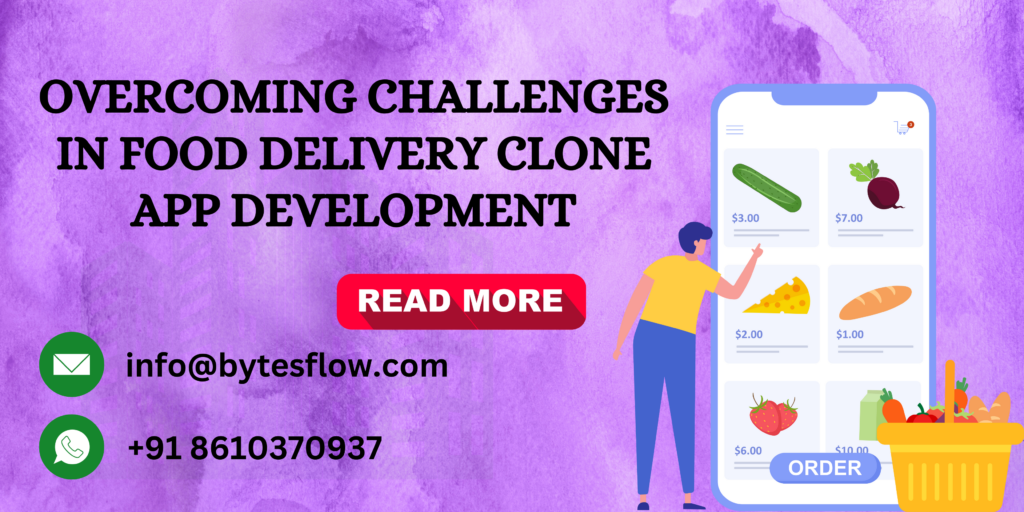The food delivery industry is booming, with countless apps like UberEats, DoorDash, and Grubhub revolutionizing the way people order and enjoy their meals. Developing a food delivery clone app is a promising venture for businesses looking to capitalize on this trend. Nonetheless, it presents its own obstacles. This blog explores the common challenges faced in food delivery clone app development and offers solutions to address them effectively.
Challenges in Food Delivery Clone App Development & How to Overcome Them

1. Ensuring Seamless User Experience
Providing a seamless and intuitive user experience is paramount for the success of any food delivery clone app. Users expect a smooth, hassle-free process from browsing menus to placing orders and tracking deliveries. Any glitch or lag can lead to user frustration and app abandonment.
Solution:
- User-Centric Design: Emphasize the importance of a user-friendly interface that makes navigating easy. Conduct thorough testing with users to pinpoint and address any potential challenges.
- Performance Optimization: Maximize the app’s speed and ensure its reliability. Ensure quick loading times and minimize crashes by leveraging efficient coding practices and regular performance testing.
- Personalization: Implement features like personalized recommendations based on user preferences and order history to enhance user engagement and satisfaction.
2. Integration with Multiple Payment Gateways
Providing multiple payment options is crucial to cater to a diverse user base. However, integrating various payment gateways securely and efficiently can be complex.
Solution:
- Diverse Payment Options: Incorporate popular payment methods such as credit/debit cards, digital wallets, and cash on delivery to cater to different user preferences.
- Security Measures: Implement robust encryption and secure socket layers (SSL) to protect sensitive payment information. Ensure compliance with PCI-DSS standards to enhance user trust.
- Seamless Integration: Choose reliable payment gateway providers and utilize their APIs for smooth and secure transactions. Regularly update and test payment gateway integrations to maintain functionality.
3. Real-Time Order Tracking
Real-time order tracking is a critical feature for a food delivery clone app. Implementing accurate and reliable tracking requires seamless integration with GPS and mapping services.
Solution:
- GPS Integration: Utilize advanced GPS technologies to deliver precise real-time tracking of orders. Ensure the app can accurately locate delivery personnel and estimate delivery times.
- User Notifications: Keep users informed with timely notifications about their order status, including confirmations, preparation updates, and delivery tracking.
- Map APIs: Utilize reliable map APIs (like Google Maps) for accurate location services and route optimization, ensuring efficient delivery processes.
4. Managing Delivery Logistics
Coordinating deliveries, managing delivery personnel, and optimizing delivery routes are complex tasks that require robust logistical solutions.
Solution:
- Efficient Dispatch System: Implement an automated dispatch system to assign orders to delivery personnel based on factors like proximity, availability, and order priority.
- Route Optimization: Use advanced algorithms and mapping services to optimize delivery routes, reducing delivery times and improving efficiency.
- Delivery Personnel Management: Develop features to track and manage delivery personnel, including real-time location tracking, performance monitoring, and shift scheduling.
5. Ensuring Data Privacy and Security
A food delivery clone app is safeguarding sensitive user data, which includes personal information and payment details. Ensuring data privacy and security is crucial to maintaining user trust and complying with regulations.
Solution:
- Data Encryption: Implement strong encryption protocols to protect user data both in transit and at rest. Utilize secure servers and databases to store sensitive information.
- Compliance: Ensure the app complies with data protection regulations like GDPR and CCPA. Regularly update privacy policies and obtain user consent for data collection and usage.
- Regular Audits: Conduct regular security audits and vulnerability assessments to identify and rectify potential security issues. Stay updated with the latest security trends and implement necessary measures.
6. Handling High Traffic and Scalability
As the food delivery clone app gains popularity, it must handle high traffic volumes and scale effectively to accommodate growing user demands without compromising performance.
Solution:
- Scalable Architecture: Design the app architecture to be scalable, allowing easy expansion of server resources and database capacity as user demand grows.
- Load Balancing: Implement load balancing techniques to distribute traffic evenly across servers, preventing overload and ensuring consistent performance.
- Cloud Services: Utilize cloud services like AWS or Google Cloud to provide flexible and scalable infrastructure, allowing the app to handle increased traffic seamlessly.
7. Customer Support and Feedback
Providing excellent customer support and effectively handling user feedback is essential for maintaining a positive user experience and improving the app over time.
Solution:
- 24/7 Support: Offer 24/7 customer support through various channels like in-app chat, email, and phone to address user queries and issues promptly.
- Feedback Mechanism: Implement a feedback mechanism within the app to collect user reviews and suggestions. Use this feedback to make continuous improvements and enhance user satisfaction.
- Automated Responses: Utilize chatbots and automated responses to handle common queries and issues, ensuring quick and efficient support.
Sum Up: Overcoming Challenges in Food Delivery Clone App Development
Developing a food delivery clone app comes with its own set of challenges, but with the right strategies and solutions, these challenges can be effectively overcome. By focusing on providing a seamless user experience, integrating multiple payment gateways securely, ensuring real-time order tracking, managing delivery logistics efficiently, prioritizing data privacy and security, handling high traffic and scalability, and offering excellent customer support, you can create a successful and competitive food delivery app.
Embrace these solutions to build a food delivery clone app that stands out in the crowded food delivery market, attracting and retaining satisfied users.


